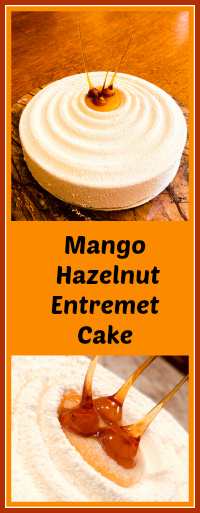Here we are, once again, baking together under the same theme, this month designed by Tanya. Doughnuts. Any kind. Baked, fried, yeast-raised, filled, glazed, or as she put it “any doughnut is a good doughnut.” She is one smart cookie, that Tanya. I went tropical (surprised?). Mine were flavored with coconut and lime, and they got a mango-glaze. The recipe was based on one from a former contestant of the Great American Baking Show, the lovely Cheryl. One of the positive aspects of passing by a certain tent is that I got to know (virtually at least) several of the former contestants and found out they are incredibly nice people!
COCONUT AND LIME DOUGHNUTS WITH MANGO GLAZE
(slightly modified from Cheryl’s blog)
for doughnuts:
2 cups (260 grams) all-purpose flour
2 teaspoons baking powder
1 teaspoon kosher salt
2/3 cup (126 grams) granulated sugar
zest of 1 lime
2 large eggs at room-temperature
1 cup coconut milk at room-temperature
1/2 cup (100 grams) coconut oil, melted
for glaze:
1 + 1/2 cup (172 grams) powdered sugar
1 tablespoon coconut milk
1 tablespoon mango Artisan flavor (Amoretti)
sprinkles to decorate
Heat the oven to 400 degrees F.
Mix the sugar with the lime zest, rubbing it well. Let it sit for 5 minutes as you gather the other ingredients. Combine the flour, baking powder and salt in a medium bowl and whisk to combine. Melt the coconut oil and set aside.
In a large bowl mix the sugar-lime, milk and the egg and whisk until the sugar is dissolved. Add the melted coconut oil (which should be cooled but still liquid) to the liquid ingredients in a steady stream and whisk constantly. Add the dry ingredients and use a spatula to fold the ingredients until you cannot see any bits of flour.
The easiest way to fill the pan is to add the batter into a piping bag, no need to add a piping tip, just cut the end. Add the batter to 12 doughnut wellsand bake for 10-12 minutes. The doughnuts are done when the you press them with your finger, and they spring back. Turn the doughnuts out on a wire rack to cool completely.
While the doughnuts are cooling combine the powdered sugar, coconut milk, mango extract and if needed adjust the consistency with lime juice or water.
Dip the doughnuts into the glaze and swirl to coat the tops and halfway down the sides. Place on a rack or parchment paper. Decorate with sprinkles.
ENJOY!
to print the recipe, click here
Comments: These turned out delicious! The flavor of the coconut was perfect, delicate and subtle, and I had to add some lime zest because I find that combination a classic. I made them to donate for the Common Table meal, and as usual, I like to think about the things that some people are not too fond of. I know that shredded coconut is a bit iffy for some, that’s why I did not do the toasted coconut topping (but please see Cheryl’s original post if you want to do it her way). I love Amoretti flavors, and had this mango bottle in my pantry begging to be used. It tastes delicious, and the glaze complemented the doughnuts the way I expected.
If you want to bake along with us, tag us in Instagram with #homebakerscollective. To see what all my baking-buddies did this month, visit our group blog, The Home Bakers Collective (post might be published later today or tomorrow morning, so keep that in mind)
Before I leave you, here is a picture of my contribution to the Common Table meal a couple of weeks ago.

Chocolate Chip Cookies (recipe from Doubletree Hilton, recently made public), Almond Tea Cakes with Boysenberry Jam, Springerle Cookies (coming soon to a food blog near you), and the doughnuts from this month’s group project.
Tanya, thank you for the challenge, I had fun planning and making them, and now I look forward to our next adventure…
Cheryl, thank you for a great recipe!
ONE YEAR AGO: Asian-Style Eggplant Meatballs
ONE YEAR AGO: Uzbek Flatbread
TWO YEARS AGO: First Monday Favorite – Black Sesame Macarons
THREE YEARS AGO: Chocolate Orange Mini-Cakes
FOUR YEARS AGO: In My Kitchen, May 2015
FIVE YEARS AGO: P90X3, a Review of Tony Horton’s Latest Fitness Program
SIX YEARS AGO: Pasta and Mussels in Saffron Broth
SEVEN YEARS AGO: Triple Chocolate Brownies
EIGHT YEARS AGO: Shanghai Soup Dumplings
NINE YEARS AGO: Bite-sized Chocolate Pleasure




























